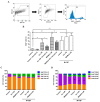Tumor-Released Products Promote Bone Marrow-Derived Macrophage Survival and Proliferation
- PMID: 34680504
- PMCID: PMC8533124
- DOI: 10.3390/biomedicines9101387
Tumor-Released Products Promote Bone Marrow-Derived Macrophage Survival and Proliferation
Abstract
Macrophages play a central role within the tumor microenvironment, with relevant implications for tumor progression. The modulation of their phenotype is one of the mechanisms used by tumors to escape from effective immune responses. This study was designed to analyze the influence of soluble products released by tumors, here represented by the tumor-conditioned media of two tumor cell lines (3LL from Lewis lung carcinoma and MN/MCA from fibrosarcoma), on murine macrophage differentiation and polarization in vitro. Data revealed that tumor-conditioned media stimulated macrophage differentiation but influenced the expression levels of macrophage polarization markers, cytokine production, and microRNAs of relevance for macrophage biology. Interestingly, tumor-derived soluble products supported the survival and proliferation rate of bone marrow precursor cells, an effect observed even with mature macrophages in the presence of M2 but not M1 inducers. Despite presenting low concentrations of macrophage colony-stimulating factor (M-CSF), tumor-conditioned media alone also supported the proliferation of cells to a similar extent as exogenous M-CSF. This effect was only evident in cells positive for the expression of the M-CSF receptor (CD115) and occurred preferentially within the CD16+ subset. Blocking CD115 partially reversed the effect on proliferation. These results suggest that tumors release soluble products that not only promote macrophage development from bone marrow precursors but also stimulate the proliferation of cells with specific phenotypes that could support protumoral functions.
Keywords: CD115; CD16; arginase-1; macrophage proliferation; tumor-associated macrophages.
Conflict of interest statement
Authors declare no conflict of interest.
Figures



References
Grants and funding
LinkOut - more resources
Full Text Sources
Research Materials

